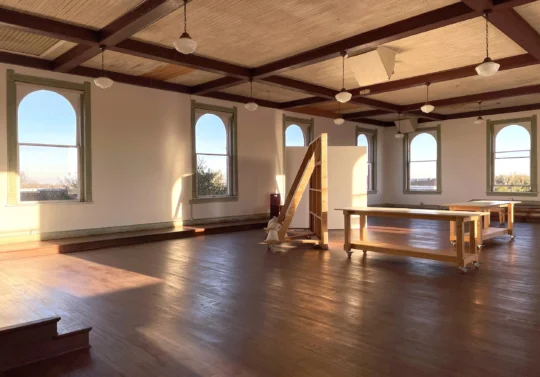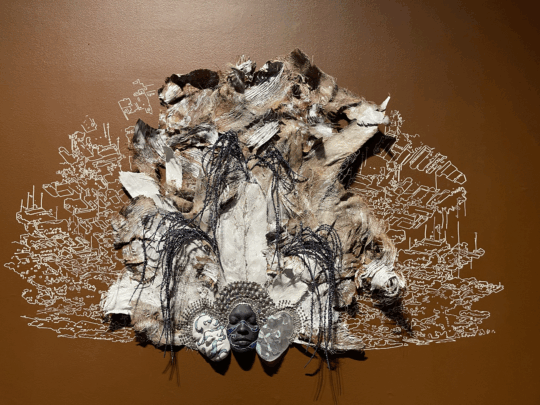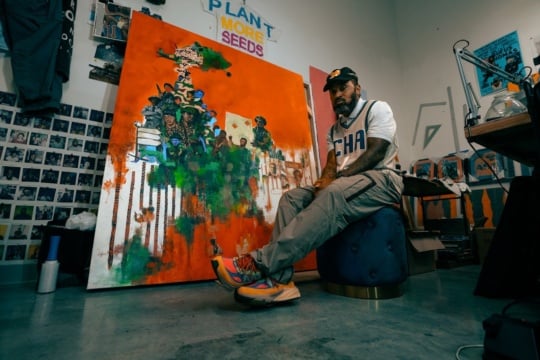
The “Topography” exhibition at Tinney Contemporary is, in a sense, a rare exhibition for Nashville, where it can be difficult to find contemporary artwork by African Americans, especially shows exclusively dedicated to their work. (To be fair, in 2013, the Frist Center hosted “30 Americans” – a major exhibition of contemporary African American art drawn from the Rubell Family Collection, and the venue currently has a show by artist Shinique Smith.)
“Topography” is an exhibition by black artists telling black stories – even the surfaces of all the works register blacks and browns and rusty umbers. In drawing attention to the widespread police violence that is commonplace in black communities, the Black Lives Matter movement has also demonstrated how often black voices are left out of this country’s cultural discourse. Throughout art history, white people have regularly told their versions of the stories of people of color, but when the artists telling their stories look like the people in those stories it’s important, it matters.
“Topography” first impresses with its contradictory scale – the show includes only six works, but each is relatively massive compared to pieces one might expect to see in a gallery the size of Tinney Contemporary. The show is curated by Jamaal Sheats, an assistant professor of art at Fisk University in Nashville, where he is also the director and curator of the Fisk University Galleries. He has created an imposing, over-the-top presentation that amplifies the voices on display through sheer pounds of mass and square feet of texture. The primarily sculptural works tell stories of community and consciousness, speaking to how individuals relate to the people and places that define their relationship to the larger culture.
The most confrontational work in the show is Wesley Clark’s My Big Black America which is a 10-by-16-foot, black-painted, wall sculpture of the United States that barely fits on the gallery wall. The piece is made up of new wood on layers of older wood representing successive generations of the black experience in America. It’s a work that points to progress over time, and that Clark made to celebrate the election of Barack Obama.
At 8 feet tall, Alfred Conteh’s Conduit is small compared to Clark’s map, and the circular wall sculpture offers a more intimate commentary. Made up of elements that combine traditional African sculpture as well as modern consumer culture, the work’s central figure is a totemic female with a face shaped like an electrical outlet. The work celebrates the central role women play in the energizing of African American communities while also pointing out how those communities combine the influences of the very new and the very old in the crafting of their identities.

Alicia Henry’s Untitled: Analagous presents the artist’s familiar dyed, painted, and stitched leather mask forms in a display that loosely recalls a family tree. The masks are in various forms of decay, and the artist seems to be relating a narrative about how isolation might happen even within the context of community. More importantly, the piece can be seen as a kind of primer for the artist’s display in the Frist Center’s current “Phantom Bodies” show, where it’s one of the most memorable highlights of that impressive exhibition.
Jamea Richmond-Edwards offers the only 2-D work in the show – an ink and charcoal diptych on black paper. Cost of Making Her Rise pictures a striking black woman in profile, a halo of light emanating from her forehead. The piece was inspired by the death of the artist’s aunt, and the split between the two halves of the image seems to be as much about mortality as it is about transcendence.

Sheats’s own Point of Entry: Door 2 is the kind of large-scale metal relief sculptures the artist is best known for. While I prefer Sheats’s more figurative work, this purely abstract piece reads more like a painting than his other pieces, and the lack of figurative imagery probably makes it a better overall fit in a gallery that’s already bursting with a massive load of information.
Tinney’s back gallery often holds surprises, and in this case it hosts my favorite work in the show. Wesley Clark’s Fluctuations is a modular wall sculpture consisting of chunky wood blocks made with plywood, masonry, nails, oil and shellac. The blocks are attached to the wall in a rectangular grid that straddles a corner of the gallery’s walls. Two middle sections are attached to look as if they are falling from the grid and cascading down the wall in a dark-stained avalanche – a number of the blocks are spread across the floor. Formally, this is the most visually interesting piece in the show, and its conceptual implications, which I feel speak to the difficulties of keeping community connected, sum-up the soul of this deeply meaningful exhibition.
“Topography” curator Jamaal B. Sheats will give a talk during Collectors Art Night this Friday, November 20, 6pm at Tinney Contemporary. The talk will be followed by “The Soundscape of Topography,” an homage by lyric-coloratura soprano, Kelsey Onwuzuruigbo accompanied by pianist Konson Rodre Patton, beginning at 7 pm.
“Topography” is on view through November 28 at Tinney Contemporary in Nashville.
Joe Nolan is a critic, columnist, and intermedia artist in Nashville. Find out more about his projects at www.joenolan.com.




